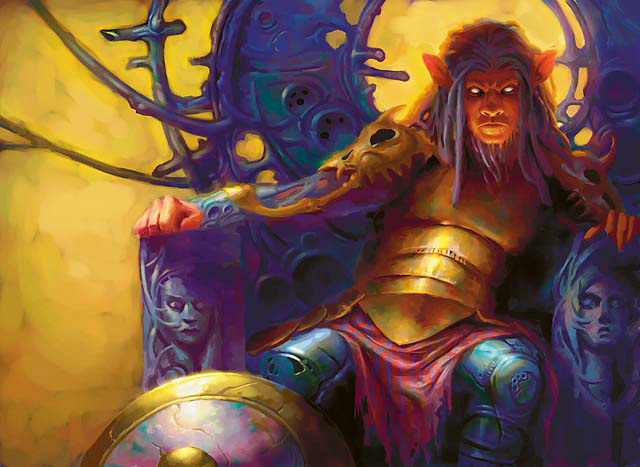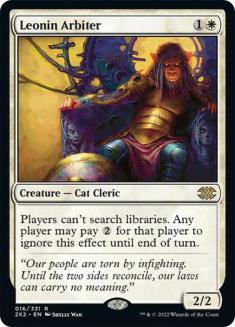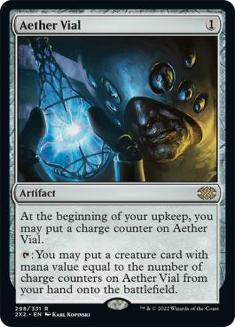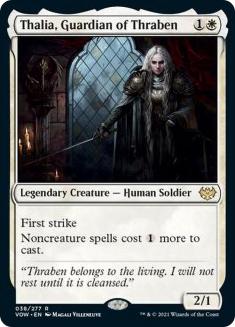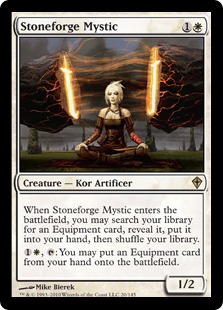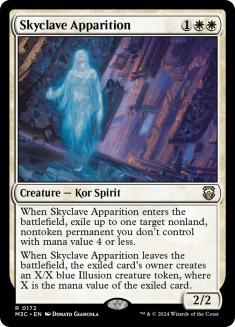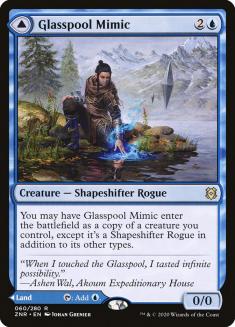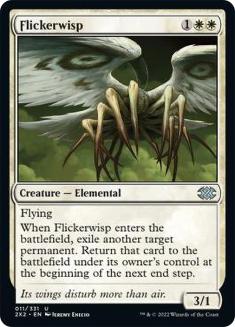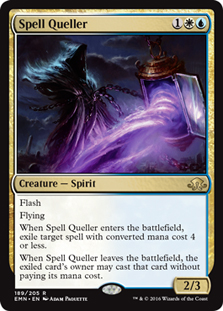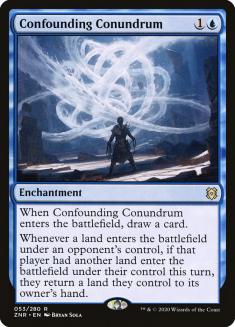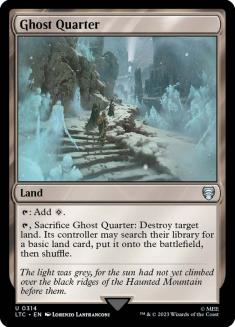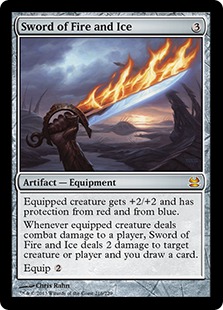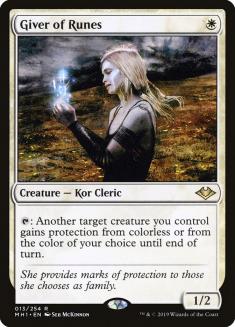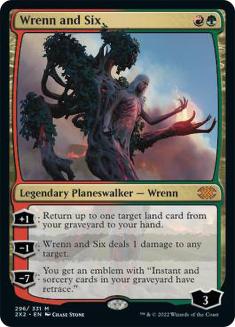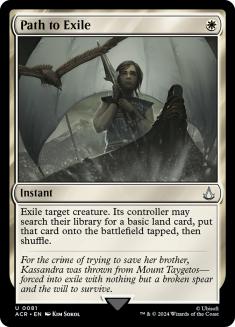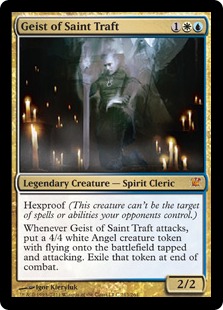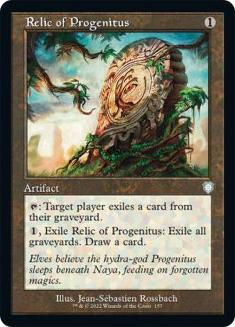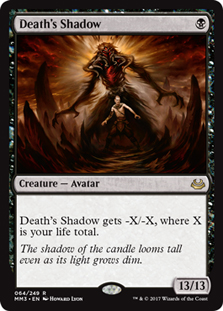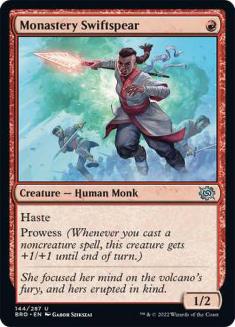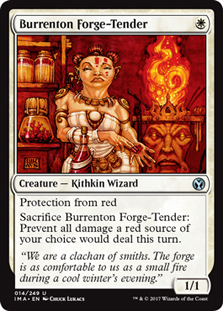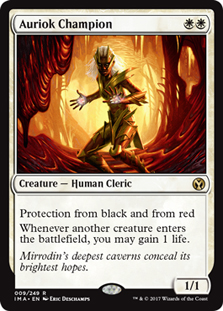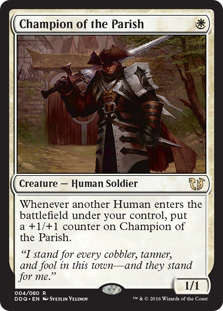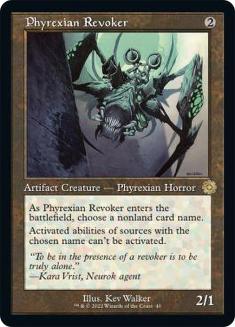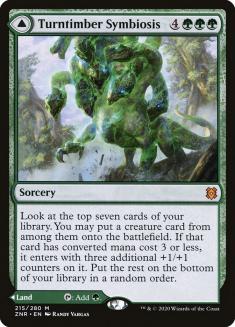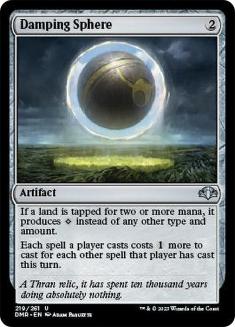The “Year of Commander” seems to have bled into Constructed across the board. It’s now just the “Year of Thick Decks.” Even before Ikoria, people were working with more than 60 for Primeval Titan and Mystic Sanctuary setups.
Creatures (34)
- 4 Flickerwisp
- 4 Stoneforge Mystic
- 4 Leonin Arbiter
- 4 Thalia, Guardian of Thraben
- 4 Spell Queller
- 4 Giver of Runes
- 2 Selfless Savior
- 4 Skyclave Apparition
- 4 Glasspool Mimic
Planeswalkers (3)
Lands (28)
Spells (15)

Recently, an Azorius Death & Taxes variant with 80 cards for Yorion, Sky Nomad started showing up in Modern Challenge results. The first time I assumed it had to be a fluke, but after the second Top 8 I felt morally obligated to give it a try. I did actually play a full League with Bant Spirits and this couldn’t be worse, right?
Somehow, adding a color and twenty cards to Death & Taxes made it better.
But Seriously, 80 Cards?
Why does adding cards to Death & Taxes make it better? Isn’t the deck miles better when it draws an Aether Vial or a Thalia, Guardian of Thraben?
The basic improvement is not drawing your Stoneforge Mystic targets as often. The next level? You just don’t draw multiple Stoneforge Mystics as much. Once you have found your best Equipment, the next-best one is often significantly worse and the third Stoneforge Mystic is almost a Squire.
A shocking number of cards in the Death & Taxes shell follow a similar pattern of the second copy being really bad. Thalia is legendary, and Aether Vial plus Aether Vial is a noted nonbo in Modern. Leonin Arbiter is in this category, where the first copy is usually enough to set up your Ghost Quarter as Strip Mine but the second copy is a dead Runeclaw Bear if the first copy was too.
This even applies to the lands, since you can’t play Flooded Strand with Leonin Arbiter. Multiple Adarkar Wastes or even Seachrome Coast can get dicey, as can flooding out on your colorless Field of Ruin and Ghost Quarters.
Honestly, the only card I don’t feel this way about is Path to Exile, and that’s only in 40% of matchups. It’s possible we should have been building Modern Death & Taxes as three-ofs for years.
This list of Death & Taxes is also extremely good at iterating on a card if you want multiples of that effect, so running 80 cards stings a little less. When you draw a Skyclave Apparition, it’s relatively easy to trigger the effect two or three times with Flickerwisp and Glasspool Mimic. The same applies when you really do want that second Equipment off Stoneforge Mystic or that second Leonin Arbiter to send a message to your Primeval Titan opponent.
The Glasspool Mimic, or more accurately Glasspool Shores, plus Flickerwisp interaction is the other huge improvement Azorius Death & Taxes brings. In case you missed the brief period after Battle for Zendikar was released where people were Ghostly Flickering their Akoum Teeth to make a 4/5, if you blink a Glasspool Shores, it exists in exile as its creature front face and returns as a Glasspool Mimic.
My main complaint with Mono-White Death & Taxes was that it was a pile of three drops when it didn’t draw Aether Vial. Being able to play a Glasspool Shores early, knowing your Turn 3 or Turn 4 play will turn it into another body, is another phenomenal way to cheat on mana, and it naturally sets up another fancy interaction where copying Flickerwisp when it returns on your end step lets you exile an opponent’s permanent until the following end step on their turn. You get three mana and two bodies, they lose a mana or an attacker for a turn, and if you ever get into a Twitter argument about “tempo” you can just use that play as the definition and no one will disagree.
I bashed on Spell Queller in the context of Bant Spirits, but it works here. I think the key is pairing it with good protection in the form of Giver of Runes and not weird unreliable cards like Mausoleum Wanderer. Azorius Death & Taxes is also a little less of a house of cards that falls apart if one piece of removal gets through, but that may be because your random creatures don’t really build anything to begin with.
The other blue cards are in the deck mostly incidental hate that let you draw a card off Flickerwisp and Yorion. I don’t want to dismiss that functionality since having a minor engine is great, but when we get to sideboarding, you will see these cards get cut a lot. Teferi, Time Raveler only being amazing when it has good cards to bounce or spells to shut off should be obvious, but Confounding Conundrum not being default good with your Ghost Quarters and Field of Ruins probably needs a bit of explanation.
Confounding Conundrum is only a temporary setback to your opponent’s mana. As much as I love to insult Leonin Arbiter, when you line it up with Ghost Quarter, their land is gone. You can punish land-light hands from decks like Rakdos Death’s Shadow when your dream scenario occurs. With Conundrum, they just play the returned land next turn. Sure, they have to play fetchlands and then wait until your turn to fetch to keep the land around. Or they can just fetch on their turn, get the mana now, and replay the land next turn. If you are just trying to kill your opponent before they cast Primeval Titan, a Conundrum might be enough, but the rest of the time you are spending two mana upfront for marginal return.
Tips and Tricks
The easiest thing to get wrong with this deck is mess up with your Leonin Arbiter. The card is every kind of embarrassing if it doesn’t work and potentially game-ending when it does.
First off, there are the things that will make you feel like an idiot that hopefully I can save you from. You don’t want to run Stoneforge Mystic into your own Leonin Arbiter. If you Field of Ruin when you control Leonin Arbiter, you also won’t be able to search. If your opponent has paid for Leonin Arbiter, it still applies for the rest of the turn, so don’t be shocked if an end-step Path to Exile gives them a land.
The actual strategy? If I have a Ghost Quarter, I usually prioritize other Turn 2 plays before Leonin Arbiter. I’m not going to skip a drop to conceal it, but there’s equity to not exposing Arbiter to removal and not letting your opponent leave up mana out of fear of a Ghost Quarter.
If you leave up mana to cast Spell Queller and your opponent doesn’t run a spell into it, your default should be just casting it. You only want to hold it if you are making progress while leaving it up moving forward, and even then you should check the math and think about the extra damage speeding up your clock.
If you’re setting up the Flickerwisp + Glasspool Shores interaction with a Skyclave Apparition, you can either directly copy the Apparition or copy Flickerwisp and blink it to get the extra exile (unless you need the extra flyer).
If you’re going to Flickerwisp a Skyclave Apparition, try to land the first exile on a cheaper permanent. Your opponent will get an Illusion token, and if it’s a 1/1 instead of a 3/3, your Apparition can still battle.
Remember that activating Ghost Quarter on your opponent’s end step without Arbiter or Conundrum is rarely better than untapping and seeing if the card you drew changes anything.
While Batterskull is still the most common Stoneforge Mystic target, I find Sword of Fire and Ice a lot more than I have found Swords with other Stoneforge Mystic decks. Azorius Death & Taxes isn’t a deck that raw powers anyone out. It’s the classic case of “Don’t wrestle a pig; you will both get dirty and the pig likes it.” You’re just trying to drag your opponent into scrappy games where your deck will be better-prepared for the garbage fight. The card advantage offered by Sword of Fire and Ice is one way you win those fights, where Batterskull might end up getting bricked by one of the many larger threats in the format without dealing true lethal damage.
Don’t forget the Illusion tokens off Skyclave Apparition are randomly blue and Sword of Fire and Ice grants protection from them.
You can bounce your own permanents with Teferi, Time Raveler. There’s the Spell Queller interaction where this locks out recasting the exiled spell, but Teferi can bounce Flickerwisp and get blinked for a card draw loop.
While you’re playing 80 cards to include it, Yorion isn’t a core element of your deck. It’s a lever you pull if your small creatures are getting stalled out and slightly outclassed by another fair deck. Some of this is the curve clustering at three mana, which tends to leave you with action in hand and without mana to spend on the companion ability. In case you’re wondering, I have yet to tick my Aether Vial up to five.
Mulligan Strategy
Azorius Death & Taxes is not a London Mulligan deck. The vast majority of your mulligans are obvious “not enough lands, not enough spells” hands that fail to function. In Games 2 and 3 you can mulligan towards specific interaction, but most Modern matches aren’t played with open decklists. You keep hands that just do things.
Doing things certainly implies taking game actions before Turn 3. Don’t keep hands that are just lands, three-drops, and Equipment.
“Doing things” also implies doing things that matter. Like I mentioned there’s some guessing about what is going to matter in a matchup, but there are hands that take game actions that almost surely won’t do that.
The prior rule about keeping hands with action before Turn 3 usually covers this, with Giver of Runes; Aether Vial with creatures; Thalia, Guardian of Thraben; and Stoneforge Mystic all being relevant early plays. The hands you should question are those with Leonin Arbiter as your early play and nothing that leverages it. Depending on the three-drops in your hand these hands can be fine with upside of drawing a Ghost Quarter, or terrible hands that won’t beat anything.
The Matchups
Vs Uro Piles
The main concern in these matchups is always going to be your opponent’s permanents. Uro, Titan of Nature’s Wrath; Wrenn and Six; Omnath, Locus of Creation; or their good expensive planeswalkers will all bury your chip shot gameplan if unopposed.
You can use Flickerwisp or Spell Queller to manage an escaped Uro, while you need to have Skyclave Apparition for a Wrenn or Omanth. You can’t always just save a Flickerwisp for later since their removal does force you to produce more threats, but if you are given the choice of how to line everything up, try to keep your answer options open for the future. There’s also some consideration to Flickerwisp giving them a card and life back even if it kills the Uro, so I would still Apparition an Uro if my opponent was low on cards and unlikely to have a follow-up threat.
On a similar note, take care with casting your one-toughness creatures into a future Wrenn and Six. Wrenn doesn’t tend to sit in your opponent’s hand, but if they haven’t had a good window to cast the card, consider casting something that isn’t Flickerwisp first.
Confounding Conundrum is decent in this matchup even if they can use it to loop Mystic Sanctuary. Messing with their mana is nice early, but really you just want the cantrip to blink to find more threats against their interaction.
Out:
In:
If your opponent is Temur and not Four-Color or Sultai you can consider Burrenton Forge-Tenders. If your opponent is the Felidar Guardian combo version you still want a couple Path to Exile and probably the Phyrexian Revokers, trimming some lower impact things like Conundrum.
Vs Rakdos Death’s Shadow (Lurrus)
Kill all their stuff. Then kill them. All your removal exiles so their Lurrus of the Dream-Den isn’t a huge issue, but if given the chance to pile blockers in front of a prowess creature, you take it and send their creature to the graveyard.
This also means timing your Skyclave Apparitions is critical. When you have Aether Vial, you want to time it to immediately Mimic or Flickerwisp for another removal trigger without letting your opponent kill your Apparition.
You can also steal games with Thalia, Guardian of Thraben and Leonin Arbiter. “Steal” is the important word, because the “killing all their stuff” plan is significantly better.
Out:
In:
Against similar decks like classic Jund Midrange or Izzet Prowess that feature Tarmogoyf or Bedlam Relever, I would also add Relic of Progenitus, trimming on Teferi, Time Raveler.
VS Humans
Yet again, you’re trying to kill a lot of things. The problem is Humans has way more things than Rakdos Death’s Shadow, but the upside is they’re way worse at breaking up your reuses of Skyclave Apparition. Your hands that are most likely to win have that card, often with a fast Batterskull off Stoneforge Mystic, and from there if anything else is needed you have Yorion to close out.
If you don’t have Skyclave Apparition, you can do a lot of work with Flickerwisp. Resetting Aether Vial or Champion of the Parish can keep the game at parity. Giver of Runes making combat a mess also can help you win games without that key card.
Out:
In:
Your sideboarding isn’t the best here, but you make do. You really wish you could cut some Thalias, but the tradeoff of an 80-card deck is sometimes coming up a bit short in sideboarding. Phyrexian Revoker is pulling a classic maneuver and going after Aether Vial when you don’t draw yours, or just cutting off Noble Hierarch to bring Leonin Arbiter back onto the battlefield.
VS Oops All Spells
Just your reminder of how Ghost Quarter works against a deck that will control lands but doesn’t play lands. Also of how Flickerwisp exiling Agadeem, the Undercrypt leaves it gone forever.
Out:
In:
Other decks are shifting towards Surgical Extraction for this matchup, but your maindeck interaction is good enough that you can live with Relic of Progenitus. I think Containment Priest or Surgical Extraction might be better than the Rest in Peaces, or maybe just all the Relics.
Teferi isn’t great in this matchup, but you can use it to recycle Flickerwisp and kill more lands. Skyclave Apparition is similarly not good but can handle Pentad Prism. All Path to Exile does is let you turn your creatures into lands, which is really conditional.
If your opponent is on the stock list, Phyrexian Revoker can actually make their combo kill significantly harder even if they have Balustrade Spy instead of Undercity Informer. By naming Salvage Titan and stopping that recursion ability, you cut off their free second creature cast for Vengevines. Some lists will sideboard into Thassa’s Oracle to also sidestep graveyard hate so this isn’t 100% effective, but it’s a good default name if you aren’t catching a Pentad Prism.
VS Big Mana
This is Confounding Conundrum’s time to shine. That card is a disaster for Primeval Titan decks and makes your Ghost Quarter plan against Urza’s Tower decks much less likely to run into the “hard-cast Ugin, the Spirit Dragon anyway” plan. Aim for their lands and be proactive. Eldrazi Tron throws a bit of dealing with a 5/5 attacker into the mix there, but it’s all about the same. Skyclave Apparition largely handling Karn, Scion of Urza and its sideboard targets is a lifesaver, but be aware Eldrazi Tron can just find Skysovereign, Consul Flagship instead of Ensnaring Bridge.
Out (VS Amulet Titan):
In (VS Amulet Titan):
There are obviously some variations depending on your opponent’s exact deck within the Big Mana spread. I want Giver of Runes against Eldrazi Tron to gum up combat, where Selfless Savior tends to die to Walking Ballista and not stop any sweepers. Against the Elvish Reclaimer + Primeval Titan lists Damping Sphere does nothing, but again Giver of Runes helps since they have Path to Exiles.
I don’t love Geist of Saint Traft in any of these matchups, but it’s at least fine. I really like it against Uro decks, but if you expected more opponents to be bringing Big Mana or random combo decks, I would definitely swap those slots to Meddling Mages.

